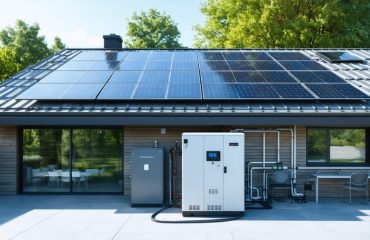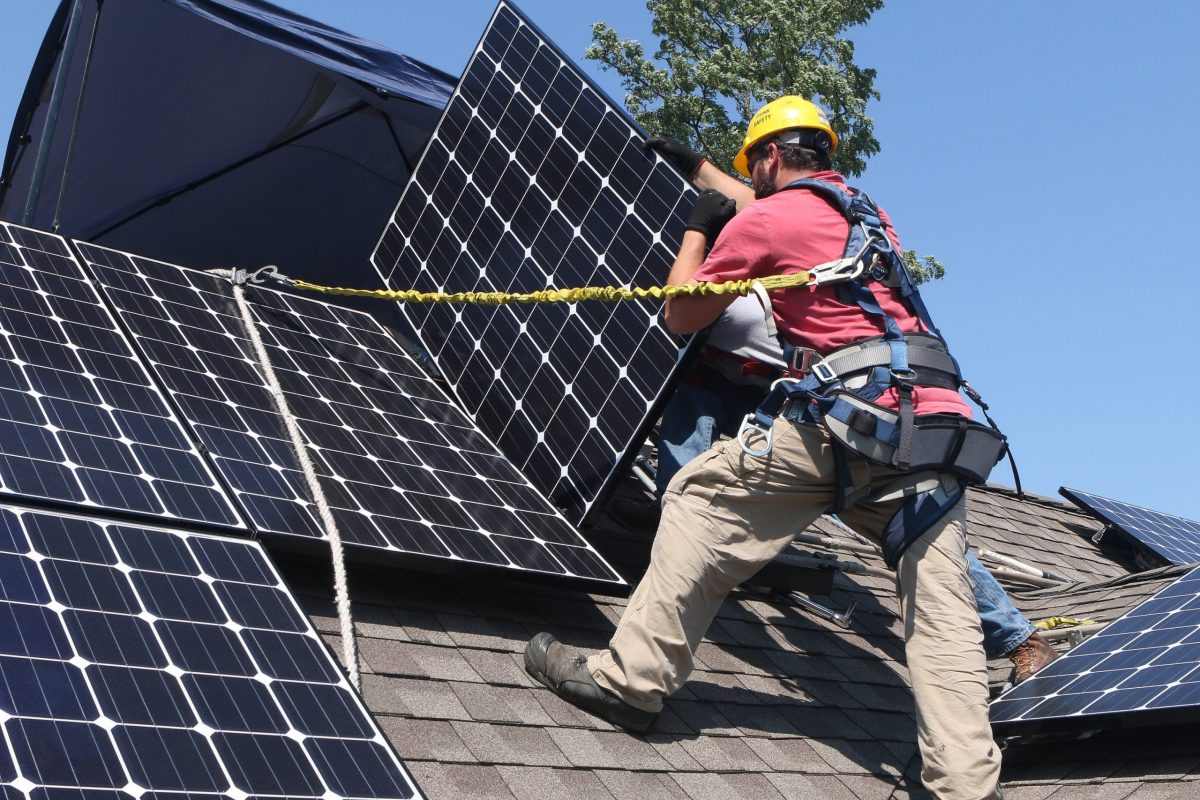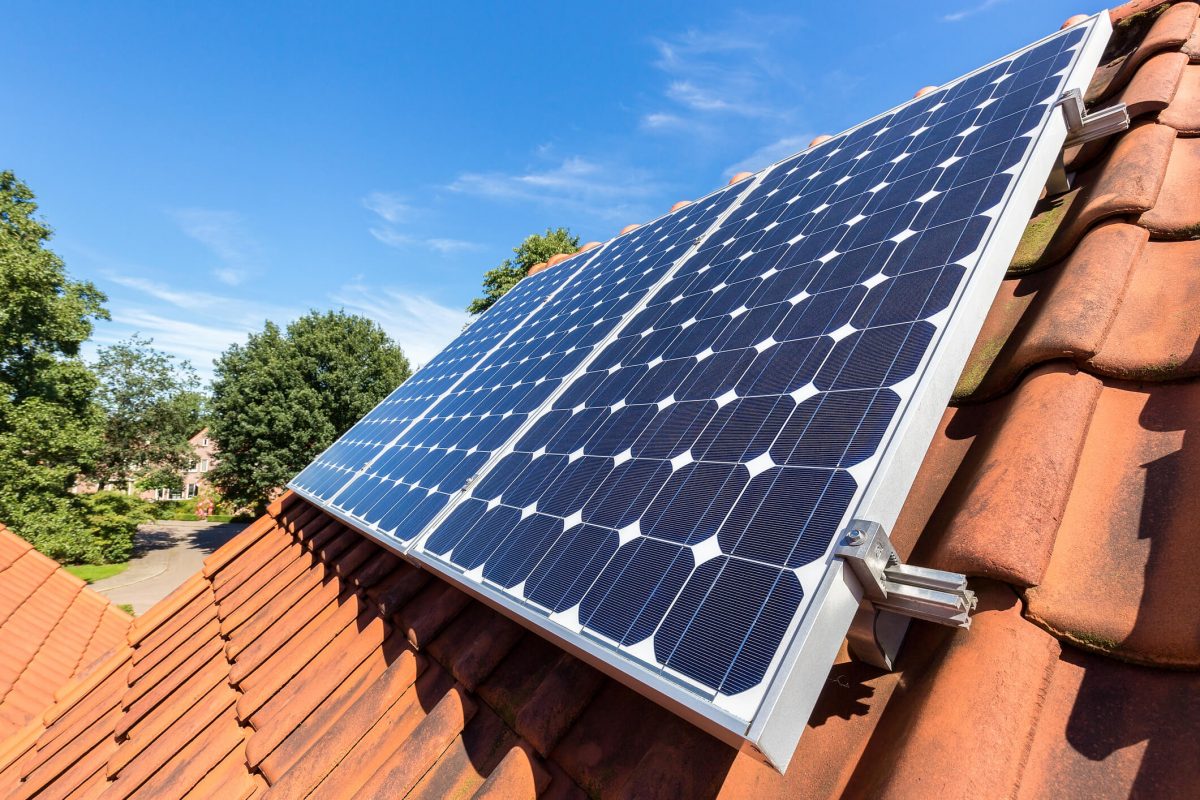Biomass energy transforms organic materials—wood pellets, agricultural waste, even yard trimmings—into heat and electricity for your home, offering a practical pathway to energy independence that complements solar power beautifully.
Unlike fossil fuels that take millions of years to form, biomass replenishes itself within human timescales, making it truly renewable. When you burn wood pellets or biogas, you’re releasing carbon that trees absorbed just years ago, creating a much shorter carbon cycle than coal or natural gas. The science is straightforward: plants capture sunlight and CO2, you harvest and convert that stored energy, then new plants grow to restart the cycle.
Homeowners already using biomass heating systems report 30-50% reductions in winter energy costs compared to traditional heating oil or propane. Modern biomass boilers and pellet stoves have evolved dramatically—they’re clean-burning, automated, and surprisingly efficient. You’re not dealing with smoky, labor-intensive wood stoves from decades past.
The real power emerges when you combine biomass with solar panels. Solar handles your electrical needs during sunny months, while biomass provides reliable heating during cold, dark winters when solar production dips. This dual approach addresses the intermittency challenge that often concerns homeowners exploring renewables, giving you genuine independence from utility price fluctuations and supply disruptions.
Understanding how biomass fits into your comprehensive energy strategy means recognizing it’s not competing with solar—it’s completing your renewable energy ecosystem.
What Is Renewable Biomass Energy?
The Simple Science Behind Biomass
Understanding biomass energy is simpler than you might think—it’s nature’s way of recycling energy. At its core, biomass converts organic materials like wood, agricultural waste, or even food scraps into usable power through three main processes.
**Combustion** works just like your fireplace: burning organic material releases stored energy as heat, which can warm your home or generate electricity. It’s the most straightforward method and has powered human civilization for millennia.
**Gasification** takes things a step further—think of it as controlled burning in low-oxygen conditions. This process transforms biomass into a combustible gas mixture, similar to natural gas, which burns cleaner and more efficiently than direct combustion.
**Anaerobic digestion** is nature’s composting on steroids. Microorganisms break down organic waste without oxygen, producing biogas (mainly methane) that can fuel generators or heating systems. This process actually mimics what happens naturally in landfills, but captures the energy instead of wasting it.
The beauty of these methods? They’re turning waste into watts, creating a practical solution that reduces landfill burden while generating power.
Common Sources You Already Know
You’re probably already handling biomass materials without realizing it. Every time you rake leaves, trim branches, or bag grass clippings, you’re dealing with potential energy sources. That pile of wood chips from last year’s tree trimming? It could power homes. Even your kitchen scraps—vegetable peels, coffee grounds, and eggshells—contain energy that can be captured and converted into electricity or heat.
Agricultural areas produce enormous amounts of biomass too. Corn stalks left after harvest, wheat straw, and rice husks all qualify. If you heat your home with a wood stove, you’re already using biomass energy in its most direct form. Wood pellets, which many homeowners use for heating, are simply compressed sawdust and wood waste that burns efficiently and cleanly.
The beauty of these materials is that they’re constantly regenerating. Unlike fossil fuels buried underground for millions of years, biomass grows back season after season. Your lawn will need mowing again, trees will drop more leaves, and farmers will harvest new crops—creating a perpetual cycle of renewable energy potential from sources already part of everyday life.
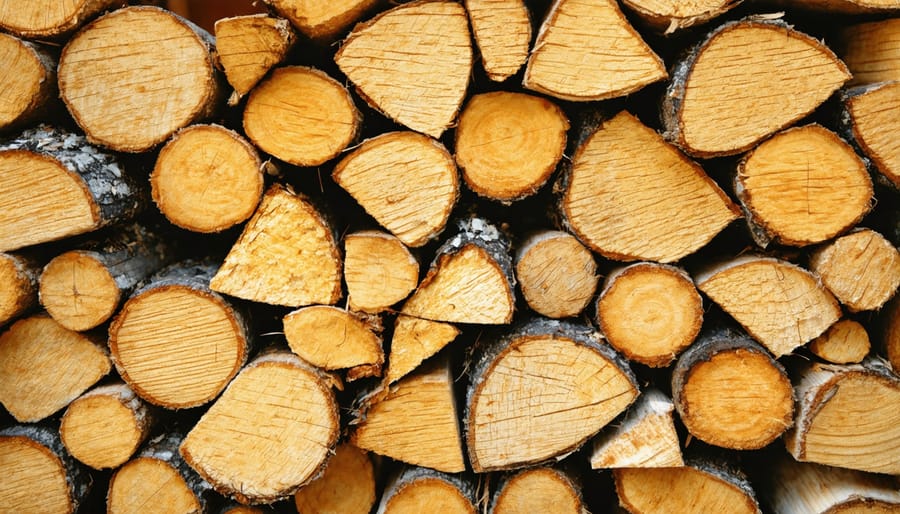
Why Biomass Matters for True Energy Independence
When the Sun Doesn’t Shine
One of the biggest advantages biomass energy has over solar power is its reliability. While solar panels depend entirely on sunshine, biomass systems generate power whenever you need it—day or night, rain or shine.
This makes biomass an excellent partner to solar energy rather than a competitor. During those gray winter months when your solar panels produce significantly less electricity, a biomass system can pick up the slack. The same goes for nighttime hours when solar production drops to zero but your household still needs power for heating, cooking, and appliances.
Think of it this way: solar captures abundant daytime energy during sunny seasons, while biomass provides steady backup power during gaps in production. Together, they create a more complete energy independence solution than either technology could achieve alone.
For homeowners serious about reducing reliance on the grid, this consistency matters tremendously. You won’t face anxious moments wondering if clouds or darkness will leave you short on power. Biomass fuels like wood pellets, chips, or agricultural waste can be stored on your property, giving you control over your energy supply regardless of weather conditions. This dependable, on-demand characteristic is what makes biomass such a valuable complement to your renewable energy strategy.
Local Energy, Local Control
One of biomass energy’s most compelling advantages is its ability to put power back in your hands—literally. Unlike electricity that travels hundreds of miles through utility grids, biomass energy relies on materials you can often source right in your own backyard or community. Wood pellets, agricultural waste, and yard trimmings become fuel sources that don’t require corporate middlemen or fluctuating market prices.
This local approach means genuine energy independence for homeowners. When you heat your home with a wood pellet stove or biomass boiler, you’re not waiting for utility companies to restore power during outages or absorbing rate increases decided in distant boardrooms. You’re making decisions based on your needs and your budget.
Communities benefit too. Biomass systems create local jobs in harvesting, processing, and distribution—keeping energy dollars circulating in your area rather than disappearing to out-of-state corporations. This strengthens local economies while reducing the environmental costs of long-distance energy transportation.
For homeowners exploring energy independence, biomass offers a tangible, manageable starting point. You control your fuel supply, maintenance schedule, and usage patterns. Combined with solar panels for electricity and biomass for heating, you’re building a resilient energy strategy that doesn’t rely on external forces you can’t control.
The Financial Reality: Does Biomass Make Sense for Homeowners?
Upfront Costs vs. Long-Term Savings
Installing a residential biomass heating system typically costs between $8,000 and $20,000, depending on the size and type of unit you choose. A pellet stove for a single room runs on the lower end, while a whole-home biomass boiler sits at the higher range. Don’t forget to factor in chimney installation or upgrades, which can add $1,000 to $3,000 to your initial investment.
The good news? Your payback period is often shorter than you’d expect. With pellet fuel averaging $250 per ton and heating oil or propane prices continuing to climb, most homeowners recoup their investment in 5 to 10 years. If you’re replacing electric heating, you could see savings of $800 to $1,500 annually on your energy bills.
How does this compare to solar? Residential solar panel systems typically cost $15,000 to $25,000 after federal tax credits, with payback periods of 6 to 12 years. The key difference: solar generates electricity year-round, while biomass primarily tackles heating needs. Many homeowners find the sweet spot is combining both technologies—solar for electricity and biomass for heating—creating a comprehensive renewable energy strategy.
Before jumping in, check for local and federal incentives. The Biomass Stove Tax Credit can cover up to 26% of installation costs, significantly reducing your upfront expense and shortening your payback timeline. Your state may offer additional rebates that make biomass heating even more attractive financially.
The Hidden Costs Nobody Talks About
While biomass energy offers real benefits, it’s important to understand the practical realities before diving in. Think of it like maintaining a swimming pool—there’s upfront excitement, but ongoing attention keeps things running smoothly.
**Fuel Supply and Storage**
Unlike solar panels that simply capture sunlight, biomass systems need a steady supply of wood pellets, chips, or other organic materials. You’ll need dry storage space—typically a covered area protecting several weeks’ worth of fuel from moisture. Wet biomass burns inefficiently and can damage equipment. Budget for regular fuel deliveries or plan time for sourcing materials yourself.
**Maintenance Requirements**
Biomass boilers and stoves require more hands-on care than conventional heating systems. Expect to remove ash weekly during heating season, clean heat exchangers monthly, and schedule annual professional servicing. These aren’t dealbreakers, but they do require time and consistency. Many homeowners find the routine meditative, though it’s definitely more involved than adjusting a thermostat.
**Real-World Costs**
Beyond the initial equipment investment, factor in fuel costs (typically $200-400 per ton for pellets), annual maintenance ($150-300), and occasional parts replacement. The good news? These expenses are often offset by lower heating bills, especially if you’re replacing expensive oil or propane systems. Many homeowners report breaking even within 5-7 years while enjoying greater energy independence.
The key is going in with realistic expectations about your time and budget commitment.
Biomass and Solar: Why They Work Better Together
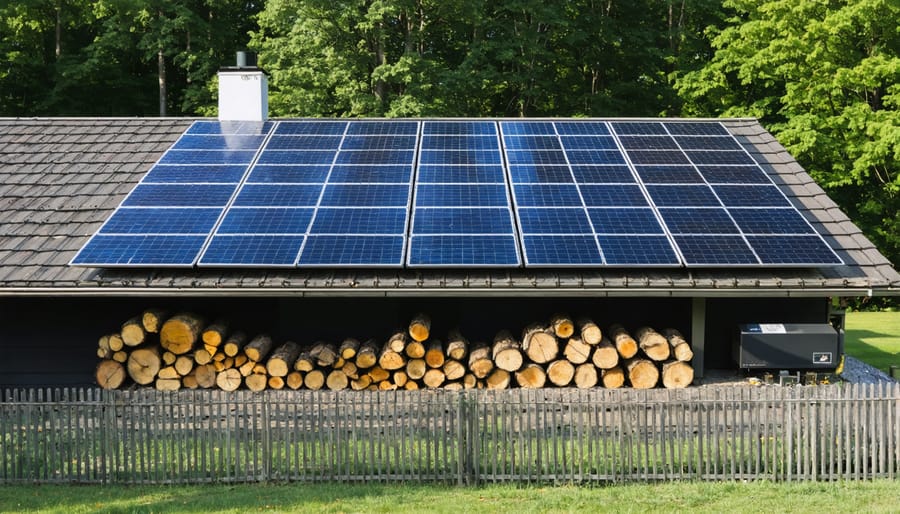
Creating Your Personal Energy Mix
Many homeowners are discovering that the best approach isn’t choosing between solar and biomass—it’s using both strategically. A typical setup combines rooftop solar panels that generate electricity during sunny days with a biomass heating system that provides consistent warmth throughout winter months.
Here’s how this works in practice: Solar panels handle your daytime electricity needs—powering appliances, lighting, and electronics while feeding excess energy to batteries or the grid. Meanwhile, a modern pellet stove or biomass boiler uses wood pellets or other organic materials to heat your home efficiently, often at a fraction of propane or heating oil costs.
The real advantage comes during power outages or cloudy stretches. While your solar system might underperform on overcast days, your biomass heater continues delivering reliable warmth without grid dependency. Some homeowners even integrate biomass-powered generators as backup electricity sources.
This dual approach represents comprehensive energy solutions that address different needs: solar maximizes clean electricity production, while biomass ensures heating reliability. Together, they create redundancy that significantly reduces your reliance on utility companies while cutting energy bills year-round.
The Role of Energy Storage
Whether you’re generating power from solar panels, biomass systems, or both, energy storage solutions are the key to maximizing your energy independence. Think of batteries as your energy safety net—they capture excess power when you’re producing more than you need and release it when production dips or demand increases.
Here’s the exciting part: batteries don’t discriminate between energy sources. They work seamlessly with solar during sunny days and can integrate with biomass systems that generate electricity from organic materials. This flexibility means you can store power from multiple renewable sources, creating a more resilient and reliable energy system for your home.
The real benefit? You’ll rely less on the grid and gain protection against power outages and rising utility costs. Modern battery systems are smarter than ever, automatically managing when to store, use, or even sell back excess energy. For homeowners serious about true energy independence, combining renewable generation with quality storage isn’t just smart—it’s essential for getting the most value from your investment.
Busting Common Biomass Myths
Myth: Biomass Is Just as Dirty as Coal
One of the biggest misconceptions about biomass is that burning organic material releases just as much pollution as burning coal. The truth is far more encouraging. While both release carbon dioxide, biomass operates on a closed carbon cycle—the CO2 released was recently absorbed from the atmosphere by growing plants. Coal, on the other hand, releases carbon that’s been locked underground for millions of years, adding new greenhouse gases to our environment.
Modern biomass facilities also feature advanced emission controls that capture particulates and reduce pollutants to levels far below traditional coal plants. When you combine these technologies with sustainable harvesting practices—where new trees are planted to replace what’s used—biomass becomes a genuinely renewable resource.
The key difference lies in responsible sourcing. Sustainable biomass programs ensure forests regenerate, maintaining the carbon balance. This isn’t about clear-cutting woodlands; it’s about using agricultural waste, wood processing byproducts, and managed forestry to create energy without depleting natural resources.
For homeowners considering renewable energy options, understanding this distinction matters. Biomass energy, when done right, offers a cleaner alternative to fossil fuels while supporting local forestry industries and reducing landfill waste. It’s part of a broader sustainable energy strategy that benefits both your wallet and the planet.
Myth: Biomass Systems Are Too Complicated for Homeowners
Modern biomass heating systems have come a long way from the wood stoves of yesterday. Today’s pellet stoves and automated biomass boilers are designed with homeowners in mind—not engineers. These systems feature digital controls, automatic fuel feeding, and self-cleaning mechanisms that make operation as simple as adjusting your thermostat.
Pellet stoves, for example, require only that you fill a hopper with pellets every few days and empty an ash pan occasionally. Many models connect to smartphone apps, letting you control temperature and monitor fuel levels from anywhere. Automated ignition means no more struggling with matches or kindling.
Installation is straightforward too. While professional setup is recommended, most biomass systems don’t require complex retrofitting. They can often integrate with existing heating infrastructure, and certified installers handle the technical details.
The learning curve is minimal. If you can operate a programmable thermostat, you can manage a modern biomass system. Manufacturers provide clear manuals and customer support, and routine maintenance typically involves simple tasks you can handle yourself or schedule annually with a technician—similar to maintaining a traditional furnace.
The bottom line? Today’s biomass technology puts renewable heating within reach of everyday homeowners, no technical degree required.

Renewable biomass energy represents an important piece of the clean energy puzzle, but it works best when thoughtfully integrated into a broader sustainability strategy. While biomass offers valuable benefits—particularly for heating and waste reduction—solar power remains the most accessible, cost-effective, and environmentally friendly option for most homeowners seeking energy independence.
The future of sustainable living isn’t about choosing just one renewable energy source; it’s about understanding how different technologies complement each other. Solar panels can power your home’s electrical needs while biomass heating might make sense if you have access to abundant local organic materials. The key is creating a personalized energy solution that matches your specific circumstances, location, and goals.
As you explore ways to reduce your environmental footprint and gain control over your energy costs, think holistically about your options. Solar technology has become remarkably affordable and efficient, making it the logical starting point for most households. When combined with other renewable resources where practical, you’re building true resilience and sustainability.
Ready to take the next step toward a cleaner, more independent energy future? Discover how energy independence solutions can transform your home into a self-sufficient powerhouse. The technology exists today to dramatically reduce your reliance on the grid while making a meaningful difference for our planet’s future.


